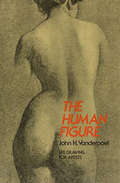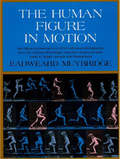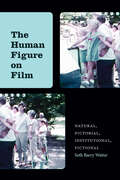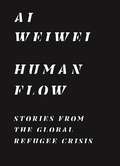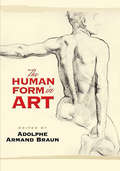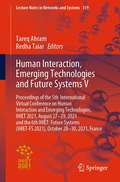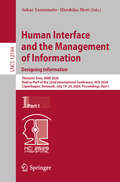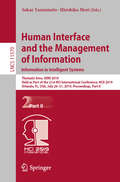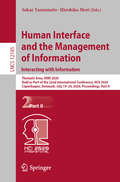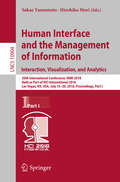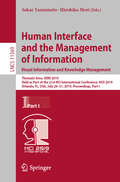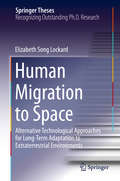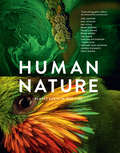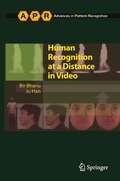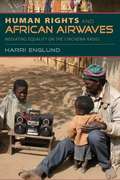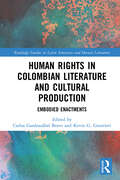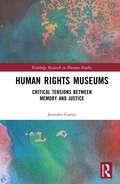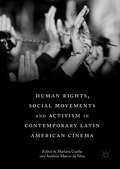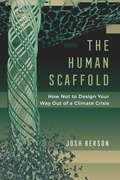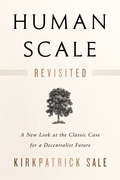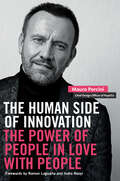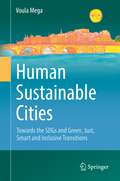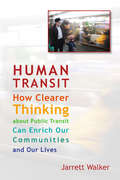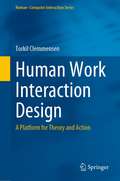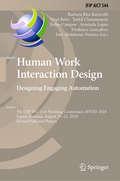- Table View
- List View
The Human Figure
by John H. VanderpoelThis great classic is still unrivalled for its clear, detailed presentation of thousands of fundamental features of the human figure. Every element of the body (such as the overhang of the upper lip; the puckering at the corners of the mouth; the characteristic proportions of the head, trunk, limbs, etc.; the tension between connected portions of the body; etc.) is carefully and concisely pointed out in the text. Even more helpful are the 430 pencil and charcoal drawings that illustrate each feature so that you are, in effect, shown what to look for by a master teacher. The result is the only art instruction book which not only illustrates details of the body but directs your attention at every stage to a host of subtle points of shading, curvature, proportion, foreshortening, muscular tension, variations due to extreme age or youth, and both major and minor differences in the structure and representation of the male and female figure. Comprehensive discussions and drawings cover the eyes; nose, mouth and chin; ear; head, trunk, back and hips; neck, throat, and shoulder; shoulder and arm; hand and wrist; leg; foot; the complete figure; and other interdependent groups of structures. This is the human figure as the artist, art student, and art teacher must know it in order to avoid many deceptive errors unfortunately common in much modern portraiture, painting, and illustrative art.
The Human Figure in Motion
by Eadweard MuybridgeThis is the largest selection ever made from the famous Muybridge sequence high-speed photographs of human motion. Containing 4,789 photographs, it illustrates some 163 different types of action: elderly man lifting log, woman sweeping, woman climbing ladder, men boxing and wrestling, child crawling, man lifting weight, man jumping, and 155 other types of action, some of which are illustrated by as many as 62 different photographs. Taken at speeds ranging up to 1/6000th of a second, these photographs show bone and muscle positions against ruled backgrounds. Almost all subjects are undraped, and all actions are shown from three angles: front, rear, and three-quarter view. These historic photographs, one of the great monuments of nineteenth-century photography, are reproduced original size, with all the clarity and detail of the originals. As a complete thesaurus of human action, it has never been superseded. Muybridge was a genius of photography, who had unlimited financial, technical, and scientific backing at the University of Pennsylvania. This volume presents the final selection from more than 100,000 negatives made at an expenditure of more than $50,000. It has never been superseded as a sourcebook for artists, students, animators, and art directors. "An unparalleled dictionary of action for all artists, photographers." -- American Artist."Impressive and valuable collection." -- Scientific American.
The Human Figure on Film: Natural, Pictorial, Institutional, Fictional (SUNY series, Horizons of Cinema)
by Seth Barry WatterThe Human Figure on Film asks what it is we look for when we look at human beings projected on a screen. People have appeared onscreen since film was invented. Nothing could be more common, and yet nothing confounds us more, than a filmed human being. Scholars and critics have attempted to reduce the mystery, creating methodologies that make this figure legible. Some of their efforts form the subject of this book.Each chapter is devoted to a single, central concept—the natural, the pictorial, the institutional, and the fictional—that viewers have used to make sense of what they see. Each concept, in turn, is tied to the work and methods of a particular kind of historical observer: the natural historian (Ray L. Birdwhistell), the aesthete or pictorialist (Victor O. Freeburg), the anthropologist of institutions (Hortense Powdermaker), and the critic of fiction (V. F. Perkins). All of these researchers have their own interests and criteria of understanding, ranging from a microscopic look at gestures to a broad view of characters. Using a combination of critical history, biography, and formal analysis, The Human Figure on Film offers a fresh approach to the problem of figuration in an age of digital cinema. It is, at once, a cross-section of the field of film studies, a handbook of methods, and an inquiry into the nature of inquiry itself.
Human Flow: Stories from the Global Refugee Crisis
by Weiwei AiA powerful portrait of the greatest humanitarian emergency of our time, from the director of Human FlowIn the course of making Human Flow, his epic feature documentary about the global refugee crisis, the artist Ai Weiwei and his collaborators interviewed more than 600 refugees, aid workers, politicians, activists, doctors, and local authorities in twenty-three countries around the world. A handful of those interviews were included in the film. This book presents one hundred of these conversations in their entirety, providing compelling first-person stories of the lives of those affected by the crisis and those on the front lines of working to address its immense challenges.Speaking in their own words, refugees give voice to their experiences of migrating across borders, living in refugee camps, and struggling to rebuild their lives in unfamiliar and uncertain surroundings. They talk about the dire circumstances that drove them to migrate, whether war, famine, or persecution; and their hopes and fears for the future. A wide range of related voices provides context for the historical evolution of this crisis, the challenges for regions and states, and the options for moving forward.Complete with photographs taken by Ai Weiwei while filming Human Flow, this book provides a powerful, personal, and moving account of the most urgent humanitarian crisis of our time.
The Human Form in Art
by Adolphe Armand BraunAs individual as a snowflake, the human body is a marvel of form and function. This dramatic compilation of 166 studies—photographs, line drawings, and sculptures—serves as both an exhilarating exhibition and an important reference. Key topics include:AnatomyProportionMotionOther advice covers the selection of models, the human form in sculpture, and the role of art in the theater. Artists at every level of experience as well as art lovers will benefit from this classic guide.
Human Interaction, Emerging Technologies and Future Systems V: Proceedings of the 5th International Virtual Conference on Human Interaction and Emerging Technologies, IHIET 2021, August 27-29, 2021 and the 6th IHIET: Future Systems (IHIET-FS 2021), October 28-30, 2021, France (Lecture Notes in Networks and Systems #319)
by Tareq Ahram Redha TaiarThis book reports on research and developments in human–technology interaction. A special emphasis is given to human–computer interaction and its implementation for a wide range of purposes such as health care, aerospace, telecommunication, and education, among others. The human aspects are analyzed in detail. Timely studies on human-centered design, wearable technologies, social and affective computing, augmented, virtual and mixed reality simulation, human rehabilitation, and biomechanics represent the core of the book. Emerging technology applications in business, security, and infrastructure are also critically examined, thus offering a timely, scientifically grounded, but also professionally oriented snapshot of the current state of the field. The book gathers contributions presented at the 5th International Conference on Human Interaction and Emerging Technologies (IHIET 2021, August 27–29, 2021) and the 6th International Conference on Human Interaction and Emerging Technologies: Future Systems (IHIET-FS 2021, October 28–30, 2021), held virtually from France. It offers a timely survey and a practice-oriented reference guide to researchers and professionals dealing with design, systems engineering, and management of the next-generation technology and service systems.
Human Interface and the Management of Information. Designing Information: Thematic Area, HIMI 2020, Held as Part of the 22nd International Conference, HCII 2020, Copenhagen, Denmark, July 19–24, 2020, Proceedings, Part I (Lecture Notes in Computer Science #12184)
by Sakae Yamamoto Hirohiko MoriThis two-volume set LNCS 12184 and 12185 constitutes the refereed proceedings of the Thematic Area on Human Interface and the Management of Information, HIMI 2020, held as part of HCI International 2020 in Copenhagen, Denmark.* HCII 2020 received a total of 6326 submissions, of which 1439 papers and 238 posters were accepted for publication after a careful reviewing process. The 72 papers presented in the two volumes were organized in the following topical sections: Part I: information presentation and visualization; service design and management; and information in VR and AR. Part II: recommender and decision support systems; information, communication, relationality and learning; supporting work, collaboration and creativity; and information in intelligent systems and environments. *The conference was held virtually due to the COVID-19 pandemic.
Human Interface and the Management of Information. Information in Intelligent Systems: Thematic Area, HIMI 2019, Held as Part of the 21st HCI International Conference, HCII 2019, Orlando, FL, USA, July 26-31, 2019, Proceedings, Part II (Lecture Notes in Computer Science #11570)
by Sakae Yamamoto Hirohiko MoriThis two-volume set LNCS 11569 and 11570 constitutes the refereed proceedings of the Thematic Area on Human Interface and the Management of Information, HIMI 2019, held as part of HCI International 2019 in Orlando, FL, USA.HCII 2019 received a total of 5029 submissions, of which 1275 papers and 209 posters were accepted for publication after a careful reviewing process. The 91 papers presented in the two volumes were organized in topical sections named: Visual information; Data visualization and analytics; Information, cognition and learning; Information, empathy and persuasion; Knowledge management and sharing; Haptic and tactile interaction; Information in virtual and augmented reality; Machine learning and intelligent systems; Human motion and expression recognition and tracking; Medicine, healthcare and quality of life applications.
Human Interface and the Management of Information. Interacting with Information: Thematic Area, HIMI 2020, Held as Part of the 22nd International Conference, HCII 2020, Copenhagen, Denmark, July 19–24, 2020, Proceedings, Part II (Lecture Notes in Computer Science #12185)
by Sakae Yamamoto Hirohiko MoriThis two-volume set LNCS 12184 and 12185 constitutes the refereed proceedings of the Thematic Area on Human Interface and the Management of Information, HIMI 2020, held as part of HCI International 2020 in Copenhagen, Denmark.* HCII 2020 received a total of 6326 submissions, of which 1439 papers and 238 posters were accepted for publication after a careful reviewing process. The 72 papers presented in the two volumes were organized in the following topical sections: Part I: information presentation and visualization; service design and management; and information in VR and AR. Part II: recommender and decision support systems; information, communication, relationality and learning; supporting work, collaboration and creativity; and information in intelligent systems and environments. *The conference was held virtually due to the COVID-19 pandemic.
Human Interface and the Management of Information. Interaction, Visualization, and Analytics: 20th International Conference, HIMI 2018, Held as Part of HCI International 2018, Las Vegas, NV, USA, July 15-20, 2018, Proceedings, Part I (Lecture Notes in Computer Science #10904)
by Sakae Yamamoto Hirohiko MoriThis two-volume set LNCS 10904 and 10905 constitutes the refereed proceedings of the 20th International Conference on Human Interface and the Management of Information, HIMI 2018, held as part of HCI International 2018 in Las Vegas, NV, USA, in July 2018.The total of 1170 papers and 195 posters included in the 30 HCII 2018 proceedings volumes was carefully reviewed and selected from 4373 submissions.The 56 papers presented in this volume were organized in topical sections named: information visualization; multimodal interaction; information in virtual and augmented reality; information and vision; and text and data mining and analytics.
Human Interface and the Management of Information. Visual Information and Knowledge Management: Thematic Area, HIMI 2019, Held as Part of the 21st HCI International Conference, HCII 2019, Orlando, FL, USA, July 26–31, 2019, Proceedings, Part I (Lecture Notes in Computer Science #11569)
by Sakae Yamamoto Hirohiko MoriThis two-volume set LNCS 11569 and 11570 constitutes the refereed proceedings of the Thematic Area on Human Interface and the Management of Information, HIMI 2019, held as part of HCI International 2019 in Orlando, FL, USA.HCII 2019 received a total of 5029 submissions, of which 1275 papers and 209 posters were accepted for publication after a careful reviewing process. The 91 papers presented in the two volumes were organized in topical sections named: Visual information; Data visualization and analytics; Information, cognition and learning; Information, empathy and persuasion; Knowledge management and sharing; Haptic and tactile interaction; Information in virtual and augmented reality; Machine learning and intelligent systems; Human motion and expression recognition and tracking; Medicine, healthcare and quality of life applications.
Human Migration to Space
by Elizabeth Song LockardHuman migration to space will be the most profound catalyst for evolution in the history of humankind, yet this has had little impact on determining our strategies for this next phase of exploration. Habitation in space will require extensive technological interfaces between humans and their alien surroundings and how they are deployed will critically inform the processes of adaptation. As humans begin to spend longer durations in space--eventually establishing permanent outposts on other planets--the scope of technological design considerations must expand beyond the meager requirements for survival to include issues not only of comfort and well‐being, but also of engagement and negotiation with the new planetary environment that will be crucial to our longevity beyond Earth. Approaching this question from an interdisciplinary approach, this dissertation explores how the impact of interior space architecture can meet both the physical and psychological needs of future space colonists and set the stage for humankind to thrive and grow while setting down new roots beyond Earth.
Human Nature: Planet Earth In Our Time: Twelve Photographers Address the Future of the Environment
by Geoff Blackwell Ruth HobdayIn Human Nature, 12 of today's most influential nature and conservation photographers address the biggest environmental concerns of our time.• Joel Sartore• Paul Nicklen• Ami Vitale• Brent Stirton• Frans Lanting• Brian Skerry• Tim Laman• Cristina Mittermeier• J Henry Fair• Richard John Seymour• George Steinmetz• Steve WinterAlongside their reflections, they present curated selections from their photographic careers. Stories and extraordinary images from around the world come together in a powerful call to awareness and action.• The United Nations has declared that nature is in more trouble now than at any other time in human history.• Extinction looms over one million species of plants and animals.• Human Nature wrestles with challenging questions: What do we have? What do we stand to lose?This book offers inspiration to environmentalists, activists, photography fans, and anyone concerned about the future of our world.• This illuminating book tackles our modern environmental future through the lens of preeminent photographers• Great gift for photographers, nature enthusiasts, those who enjoy backpacking and camping, and anyone who cares about Earth's climate and future• Add it to the shelf with books like National Geographic The Photo Ark Vanishing: The World's Most Vulnerable Animals by Joel Sartore, The Sixth Extinction: An Unnatural History by Elizabeth Kolbert, and Dire Predictions: The Visual Guide to the Findings of the IPCC by Michael E. Mann and Lee R. Kump.
Human Recognition at a Distance in Video
by Bir Bhanu Ju HanMost biometric systems employed for human recognition require physical contact with, or close proximity to, a cooperative subject. Far more challenging is the ability to reliably recognize individuals at a distance, when viewed from an arbitrary angle under real-world environmental conditions. Gait and face data are the two biometrics that can be most easily captured from a distance using a video camera. This comprehensive and logically organized text/reference addresses the fundamental problems associated with gait and face-based human recognition, from color and infrared video data that are acquired from a distance. It examines both model-free and model-based approaches to gait-based human recognition, including newly developed techniques where the both the model and the data (obtained from multiple cameras) are in 3D. In addition, the work considers new video-based techniques for face profile recognition, and for the super-resolution of facial imagery obtained at different angles. Finally, the book investigates integrated systems that detect and fuse both gait and face biometrics from video data. Topics and features: discusses a framework for human gait analysis based on Gait Energy Image, a spatio-temporal gait representation; evaluates the discriminating power of model-based gait features using Bayesian statistical analysis; examines methods for human recognition using 3D gait biometrics, and for moving-human detection using both color and thermal image sequences; describes approaches for the integration face profile and gait biometrics, and for super-resolution of frontal and side-view face images; introduces an objective non-reference quality evaluation algorithm for super-resolved images; presents performance comparisons between different biometrics and different fusion methods for integrating gait and super-resolved face from video. This unique and authoritative text is an invaluable resource for researchers and graduate students of computer vision, pattern recognition and biometrics. The book will also be of great interest to professional engineers of biometric systems.
Human Rights and African Airwaves: Mediating Equality on the Chichewa Radio
by Harri EnglundHuman Rights and African Airwaves focuses on Nkhani Zam'maboma, a popular Chichewa news bulletin broadcast on Malawi's public radio. The program often takes authorities to task and questions much of the human rights rhetoric that comes from international organizations. Highlighting obligation and mutual dependence, the program expresses, in popular idioms and local narrative forms, grievances and injustices that are closest to Malawi's impoverished public. Harri Englund reveals broadcasters' everyday struggles with state-sponsored biases and a listening public with strong views and a critical ear. This fresh look at African-language media shows how Africans effectively confront inequality, exploitation, and poverty.
Human Rights in Colombian Literature and Cultural Production: Embodied Enactments (Routledge Studies in Latin American and Iberian Literature)
by Carlos Gardeazábal BravoThis volume explores how Colombian novelists, artists, performers, activists, musicians, and others seek to enact—to perform, to stage, to represent—human rights situations that are otherwise enacted discursively, that is, made public or official, in juridical and political realms in which justice often remains an illusory or promised future. In order to probe how cultural production embodies the tensions between the abstract universality of human rights and the materiality of violations on individual human bodies and on determined groups, the volume asks the following questions: How does the transmission of historical traumas of Colombia’s past, through human rights narratives in various forms, inform the debates around the subjects of rights, truth and memory, remembrance and forgetting, and the construction of citizenship through solidarity and collective struggles for justice? What are the different roles taken by cultural products in the interstices among rights, laws, and social justice within different contexts of state violence and states of exception? What are alternative perspectives, sources, and (micro)histories from Colombia of the creation, evolution, and practice of human rights? How does the human rights discourse interface with notions of environmental justice, especially in the face of global climate change, regional (neo)extractivism, the implementation of megaprojects, and ongoing post-accord thefts and (re)appropriations of land? Through a wide range of disciplinary lenses, the different chapters explore counter-hegemonic concepts of human rights, decolonial options struggling against oppression and market logic, and alternative discourses of human dignity and emancipation within the pluriverse.
Human Rights Museums: Critical Tensions Between Memory and Justice (Routledge Research in Museum Studies)
by Jennifer CarterHuman Rights Museums presents case studies that trace how calls for historical and social justice, and the commensurate rise of a rights regime have led to the emergence of a new museological genre: the human rights museum. Presenting innovative field research conducted in new and emerging human rights museums across Asia and Latin America, the book adopts a broad museological approach. It does so by including national and community museums, as well as public and private museological initiatives, within its purview. Drawing on in-depth case studies about museums in Taiwan, Japan, Paraguay and Colombia – all discussed within their political and cultural contexts – the book examines the paradigmatic shift that has occurred within the museum field in the wake of the larger global transformations that have shaped contemporary geo-politics over the last 50 years. The diversity of geographical and political contexts, and the attention to lesser-known institutions within the canon of English museum studies literature, presents readers with a valuable opportunity to learn more about innovative museological models in non-English-speaking and non-Western contexts. Human Rights Museums will appeal to academics, scholars and students of museum studies and related disciplines, and to museum professionals seeking to know more about the diverse and evolving roles of museums in contemporary society.
Human Rights, Social Movements and Activism in Contemporary Latin American Cinema
by Mariana Cunha Antônio Márcio da SilvaThis edited collection explores how contemporary Latin American cinema has dealt with and represented issues of human rights, moving beyond many of the recurring topics for Latin American films. Through diverse interdisciplinary theoretical and methodological approaches, and analyses of different audiovisual media from fictional and documentary films to digitally-distributed activist films, the contributions discuss the theme of human rights in cinema in connection to various topics and concepts. Chapters in the volume explore the prison system, state violence, the Mexican dirty war, the Chilean dictatorship, debt, transnational finance, indigenous rights, social movement, urban occupation, the right to housing, intersectionality, LGBTT and women’s rights in the context of a number of Latin American countries. By so doing, it assesses the long overdue relation between cinema and human rights in the region, thus opening new avenues to aid the understanding of cinema’s role in social transformation.
The Human Scaffold: How Not to Design Your Way Out of a Climate Crisis (Great Transformations #2)
by Josh BersonHumanity has precipitated a planetary crisis of resource consumption—a crisis of stuff. So ingrained is our stuff-centric view that we can barely imagine a way out beyond substituting a new portmanteau of material things for the one we have today.In The Human Scaffold, anthropologist Josh Berson offers a new theory of adaptation to environmental change. Drawing on niche construction, evolutionary game theory, and the enactive view of cognition, Berson considers cases in the archaeology of adaptation in which technology in the conventional sense was virtually absent. Far from representing anomalies, these cases exemplify an enduring feature of human behavior that has implications for our own fate.The time has come to ask what the environmental crisis demands of us not as consumers but as biological beings. The Human Scaffold offers a starting point.
Human Scale Revisited: A New Look at the Classic Case for a Decentralist Future
by Kirkpatrick SaleBig government, big business, big everything: Kirkpatrick Sale took giantism to task in his 1980 classic, Human Scale, and today takes a new look at how the crises that imperil modern America are the inevitable result of bigness grown out of control—and what can be done about it. The result is a keenly updated, carefully argued case for bringing human endeavors back to scales we can comprehend and manage—whether in our built environments, our politics, our business endeavors, our energy plans, or our mobility. Sale walks readers back through history to a time when buildings were scaled to the human figure (as was the Parthenon), democracies were scaled to the societies they served, and enterprise was scaled to communities. Against that backdrop, he dissects the bigger-is-better paradigm that has defined modern times and brought civilization to a crisis point. Says Sale, retreating from our calamity will take rebalancing our relationship to the environment; adopting more human-scale technologies; right-sizing our buildings, communities, and cities; and bringing our critical services—from energy, food, and garbage collection to transportation, health, and education—back to human scale as well. Like Small is Beautiful by E. F. Schumacher, Human Scale has long been a classic of modern decentralist thought and communitarian values—a key tool in the kit of those trying to localize, create meaningful governance in bioregions, or rethink our reverence of and dependence on growth, financially and otherwise. Rewritten to interpret the past few decades, Human Scale offers compelling new insights on how to turn away from the giantism that has caused escalating ecological distress and inequality, dysfunctional governments, and unending warfare and shines a light on many possible pathways that could allow us to scale down, survive, and thrive.
The Human Side of Innovation: The Power of People in Love with People
by Mauro PorciniPepsiCo's award-winning chief design officer reveals the secret to creating life-changing innovations: putting human needs at the center of any design process.&“Innovation is an act of love-or at least it should be. Always. It is a gesture of empathy, respect, generosity, of one human being's devotion to another,&” writes Mauro Porcini at the beginning of this extraordinary book. It is in part a memoir by one of the world's leading designers-the first chief design officer at both 3M and Pepsi. But even more, it is a manifesto for a genuine, authentic, and deeply humanistic approach to design, one that aims to create personal and social value first and financial and economic value afterward. In every industry, new technologies have lowered the barrier to entry like never before. Either you design exceptional products or somebody will beat you to it. Porcini shows, through example after example and story after story, that the key to real, world-changing innovation is to put people first-not only the people we innovate for but also the people who lead the innovation process.Putting people first requires what Porcini calls unicorns: people who are in love with people, who have a genuine fire in them to create meaningful solutions for actual human beings. In this book, he describes them, celebrates them, and details their superpowers so you can find them, hire them, grow them, and retain them. Some are qualities you might expect-the ability to dream combined with the ability to execute. But when was the last time you heard an executive ask prospective hires if they were kind, optimistic, curious, or humble? Porcini uses his journey across startups and multinational corporations, through successes and failures, to create a handbook for modern innovators.
Human Sustainable Cities: Towards the SDGs and Green, Just, Smart and Inclusive Transitions
by Voula MegaThis book argues that accelerating action toward sustainability for and by cities and their inhabitants can make a huge difference to humanity’s endeavor to recover from current crises and build a sustainable future. It sheds light on cutting-edge concepts and actions toward sustainability that can taken by and for cities and with citizens. In this book, author Voula Mega takes the reader on a journey inside and across cities and highlights efforts toward a paradigmatic shift that reconciles human systems with nature. Leadership, education, innovation, trust and citizen empowerment all play a crucial role for the co-invention of a new model that balances human well-being, sustainable prosperity and the future of the planet. Building on robust evidence and inspired by best practices, Human Sustainable Cities offers compelling messages and convincing advice to all stakeholders who are striving to overcome crises, speed up the path toward resilience and preparedness and bounce forward better.
Human Transit: How Clearer Thinking about Public Transit Can Enrich Our Communities and Our Lives
by Jarrett WalkerPublic transit is a powerful tool for addressing a huge range of urban problems, including traffic congestion and economic development as well as climate change. But while many people support transit in the abstract, it's often hard to channel that support into good transit investments. Part of the problem is that transit debates attract many kinds of experts, who often talk past each other. Ordinary people listen to a little of this and decide that transit is impossible to figure out. Jarrett Walker believes that transit can be simple, if we focus first on the underlying geometry that all transit technologies share. In Human Transit, Walker supplies the basic tools, the critical questions, and the means to make smarter decisions about designing and implementing transit services. Human Transit explains the fundamental geometry of transit that shapes successful systems; the process for fitting technology to a particular community; and the local choices that lead to transit-friendly development. Whether you are in the field or simply a concerned citizen, here is an accessible guide to achieving successful public transit that will enrich any community.
Human Work Interaction Design: A Platform for Theory and Action (Human–Computer Interaction Series)
by Torkil ClemmensenAn approach to socio-technical HCI called Human Work Interaction Design (HWID) emerged around 2005. It has grown steadily, and now is the time for sharing this research with a wider audience. In this book, the HWID approach is used to discuss socio-technical HCI theory, cases, methods, and impact. The book introduces HWID as a multi-sided platform for theorizing about socio-technical HCI work design in the digital age. It presents design cases that illustrate the design of socio-technical relations, provides specific advice for researchers, consultants, and policy makers, and reflects on the open issues related to theorizing about sociotechnical HCI. The benefits of HWID include that it meets the requirement of taking both the social and the technical into account, while focusing strongly on the relationship between the social and the technical. In addition, it is truly international and explicitly considers local cultural, organizational, and technological contexts.
Human Work Interaction Design. Designing Engaging Automation: 5th IFIP WG 13.6 Working Conference, HWID 2018, Espoo, Finland, August 20 - 21, 2018, Revised Selected Papers (IFIP Advances in Information and Communication Technology #544)
by Barbara Rita Barricelli Virpi Roto Torkil Clemmensen Pedro Campos Arminda Lopes Frederica Gonçalves José Abdelnour-NoceraThis book constitutes the thoroughly refereed post-conference proceedings of the 5th IFIP WG 13.6 Working Conference on Human Work Interaction Design, HWID 2018, held in Espoo, Finland, in August 2018.The 19 revised and extended full papers presented were carefully selected for inclusion in this volume. The papers deal with the analysis and interaction design of a variety of complex work and life contexts found in different business and application domains. They focus on interaction design for work engagement taking usability of interactive systems to the next level by providing employees pleasurable and meaningful experiences via the tools used at work. The papers are organized in two sections: the first section presents cases of HWID in practice, while the second one focuses on methodological discussion.
